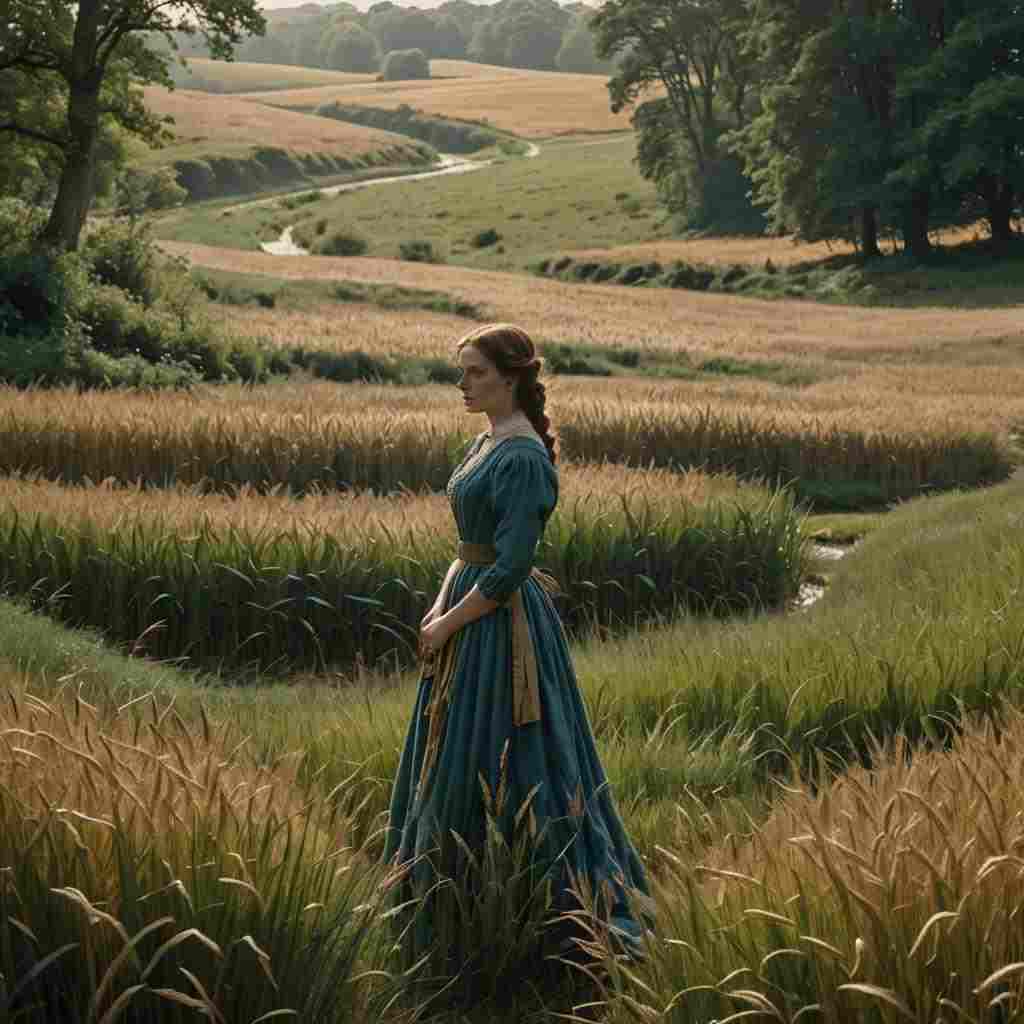The Green River
Alfred Douglas
1870 to 1945

I know a green grass path that leaves the field
And, like a running river, winds along
Into a leafy wood, where is no throng
Of birds at noon-day; and no soft throats yield
Their music to the moon. The place is sealed,
An unclaimed sovereignty of voiceless song,
And all the unravished silences belong
To some sweet singer lost, or unrevealed.
So is my soul become a silent place....
Oh, may I wake from this uneasy night
To find some voice of music manifold.
Let it be shape of sorrow with wan face,
Or love that swoons on sleep, or else delight
That is as wide-eyed as a marigold.
Alfred Douglas's The Green River
Introduction
Alfred Douglas's sonnet "The Green River" is a masterful exploration of the interplay between nature, silence, and the human soul. This poem, with its rich imagery and complex metaphorical structure, invites a deep analysis of its themes, form, and literary devices. In this essay, we will delve into the various layers of meaning within the poem, examining how Douglas uses the natural world as a mirror for the inner landscape of the human psyche.
Setting and Imagery
The poem opens with a vivid description of a "green grass path" that winds "like a running river" into a "leafy wood." This initial imagery establishes a sense of movement and fluidity, suggesting a journey or progression. The path's transformation from field to forest implies a transition from the open and known to the enclosed and mysterious. This setting serves as more than mere backdrop; it becomes a metaphor for the speaker's internal journey.
Douglas's choice of a wooded setting is particularly significant. Forests have long been used in literature as symbols of the unconscious mind, places of both danger and discovery. The specific details Douglas provides—or rather, withholds—about this wood are telling. It is described as a place with "no throng / Of birds at noon-day" and where "no soft throats yield / Their music to the moon." This absence of typical forest sounds creates an atmosphere of profound silence, which becomes a central theme of the poem.
The Theme of Silence
Silence in "The Green River" is not merely the absence of sound; it takes on an almost tangible quality. Douglas personifies silence, describing it as "unravished" and belonging to "some sweet singer lost, or unrevealed." This personification elevates silence from a simple state of being to an active force within the poem. The use of the word "unravished" is particularly striking, suggesting that this silence is pure, untouched, and potentially powerful.
The silence of the wood is mirrored in the speaker's soul, which has "become a silent place." This parallel between the external landscape and the internal state of the speaker is a key element of the poem's structure. It suggests that the journey through the silent wood is not just a physical one, but a metaphorical journey into the depths of the self.
Sonnet Structure and Rhyme Scheme
"The Green River" follows the structure of a Petrarchan sonnet, with an octave (the first eight lines) and a sestet (the final six lines). This form is particularly well-suited to the poem's content, as it allows for a turn or "volta" between the description of the external world in the octave and the reflection on the internal world in the sestet.
The rhyme scheme (ABBAABBA CDECDE) is typical of the Petrarchan sonnet form. However, Douglas uses this traditional structure to create a sense of tension between form and content. The rigid structure of the sonnet contrasts with the meandering path described in the poem, creating a fascinating interplay between constraint and freedom.
Metaphor and Allegory
The central metaphor of the poem—the path as a river—deserves close examination. Rivers in literature often symbolize the flow of life or time, and Douglas's use of this image suggests a journey of self-discovery. The path "winds along / Into a leafy wood," implying that this journey leads to a place of mystery and potential revelation.
This metaphor extends into an allegory for the creative process. The "unclaimed sovereignty of voiceless song" could be interpreted as the potential for creation that exists in silence. The "sweet singer lost, or unrevealed" might represent the artist's muse or the as-yet-unmanifested work of art.
The Turn and the Sestet
The volta occurs at the beginning of the sestet with the line "So is my soul become a silent place...." This turn shifts the focus from the external landscape to the internal state of the speaker. The ellipsis at the end of this line visually represents the silence it describes, creating a moment of pause for the reader.
In the sestet, the speaker expresses a desire to "wake from this uneasy night," suggesting that the silence, while pure and powerful, is also somewhat troubling. The speaker yearns for "some voice of music manifold," indicating a desire for creative expression or emotional release.
Ambiguity and Paradox
One of the most intriguing aspects of "The Green River" is its embrace of ambiguity and paradox. The silence of the wood is both beautiful and unsettling. The speaker both revels in and wishes to break free from this silence. Even the final lines of the poem present a series of contradictory images: "shape of sorrow with wan face," "love that swoons on sleep," and "delight / That is as wide-eyed as a marigold."
These paradoxes reflect the complex nature of creativity and self-discovery. Douglas suggests that the artistic process—and perhaps life itself—involves holding multiple, sometimes contradictory, truths simultaneously.
Symbolism
The poem is rich in symbolism, with each image carefully chosen to convey multiple layers of meaning. The "green grass path" symbolizes both a physical journey and a spiritual or creative one. The wood represents the unknown, the unconscious, and the realm of potential. The absence of birds and their songs symbolizes the silence that pervades both the external landscape and the speaker's internal world.
The final image of the marigold is particularly potent. Marigolds are often associated with the sun and creativity. By describing delight as "wide-eyed as a marigold," Douglas creates a vivid contrast to the earlier images of silence and night, suggesting the possibility of awakening and renewed creative energy.
Conclusion
"The Green River" is a poem of remarkable depth and complexity. Through its intricate interweaving of natural imagery, metaphor, and form, it explores the relationship between silence and creativity, between the external world and the internal landscape of the soul. Douglas's use of the sonnet form, with its inherent tensions between structure and content, mirrors the poem's thematic exploration of constraint and freedom.
The poem invites multiple interpretations, each reading potentially revealing new layers of meaning. It can be seen as a meditation on the creative process, an exploration of self-discovery, or a reflection on the nature of silence and sound. Ultimately, "The Green River" stands as a testament to the power of poetry to capture the ineffable aspects of human experience, inviting readers to embark on their own journey of discovery through its verdant and silent paths.
This text was generated by AI and is for reference only. Learn more
Want to join the discussion? Reopen or create a unique username to comment. No personal details required!



Comments
No comments yet. Be the first to comment!